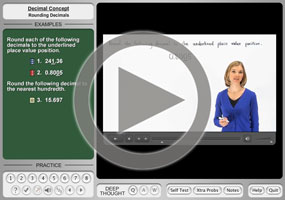Rounding Numbers
Purplemath
When you have to round a number, you are usually told how to round it. It's simplest when you're told how many "places" to round to, but you should also know how to round to a named "place", such as "to the nearest thousand" or "to the ten-thousandths place". You may also need to know how to round to a certain number of significant digits; we'll get to that later.
In general, you round to a given place by looking at the digit one place to the right of the "target" place. If the digit is a five or greater, you round the target digit up by one. Otherwise, you leave the target as it is. Then you replace any digits to the right with zeroes (if they are to the left of the decimal point) or else you delete the digits (if they are past the decimal point).
Content Continues Below
I'll use the first few digits of the decimal expansion of π: 3.14159265... in the examples below.
-
Round π to five places.
"To five places" means "to five decimal places". First, I count out the five decimal places, and then I look at the sixth place:
3.14159 | 265...
I've drawn a little line separating the fifth place from the sixth place. This can be a handy way of "keeping your place", especially if you are dealing with lots of digits.
Affiliate
The fifth place has a 9 in it. Looking at the sixth place, I see that it has a 2 in it. Since 2 is less than five, I won't round the 9 up; that is, I'll leave the 9 as it is. In addition, I will delete the digits after the 9. Then π, rounded to five places, is:
3.14159
-
Round π to four places.
First, I go back to the original number (not the one I just rounded in the previous example). I count off four places, and look at the number in the fifth place:
3.1415 | 9265...
The number in the fifth place is a 9, which is greater than 5, so I'll round up in the fourth place, truncating the expansion at four decimal places. That is, the 5 becomes a 6, the 9265... part disappears, and π, rounded to four decimal places, is:
3.1416
When rounding, you always start with the original value, count out to the specified "place", and round. You never round from the right, moving step-by-step to the left, until you reach the specified "place"!
For instance, if you were told to round 5.7445 to two decimal places, it would be wrong to say "well, 5.7445 rounds to 5.745, which rounds to 5.75." This is wrong!
Instead, use the original number, mark off the "place" in question — 5.74 | 45 — and round from there to get 5.74.
-
Round π to three places.
First, I ignore my result from the previous exercise and instead go back to the original number. I count off three decimal places, and look at the digit in the fourth place:
3.141 | 59265...
The number in the fourth place is a 5, which is the cut-off for rounding: if the number in the next place (after the one you're rounding to) is 5 or greater, you round up. In this case, the 1 becomes a 2, the 59265... part disappears, and π, rounded to three decimal places, is:
3.142
Content Continues Below
Rounding works the same way when they tell you to round to a certain named "place", such as "the hundredths place". The only difference is that you have to be a bit more careful in counting off the places you need. Just remember that the decimal places count off to the right in the same order as the counting numbers count off to the left. That is, for regular numbers, you have the place values:
...(ten-thousands) (thousands) (hundreds) (tens) (ones) (decimal point)
For decimal places, you don't have a "oneths", but you do have the other fractions:
(decimal point) (tenths) (hundredths) (thousandths) (ten-thousandths)...
For instance:
-
Round π to the nearest thousandth.
"The nearest thousandth" means that I need to count off three decimal places (tenths, hundredths, thousandths), and then round:
3.141 | 59265...
Then π, rounded to the nearest thousandth, is:
3.142
-
Round 2.796 to the hundredths place.
The hundredths place is two decimal places (just like "hundred" has two zeroes), so I'll count off two decimal places, and round according to the third decimal place:
2.79 | 6
Since the third decimal place contains a 6, which is greater than 5, I have to round up. But rounding up a 9 gives a 10. In this case, I round the 79 up to an 80:
2.80
Affiliate
You might be tempted to write this as "2.8", but, since you rounded to the hundredths place (to two decimal places), you should write both decimal places.
Otherwise, it looks like you rounded to one decimal place, or to the tenths place, and your answer could be counted off as being incorrect.
URL: https://www.purplemath.com/modules/rounding.htm
Select a Course Below
Standardized Test Prep
Homeschool Math
© 2024 Purplemath, Inc. All right reserved. Web Design by ![]()




